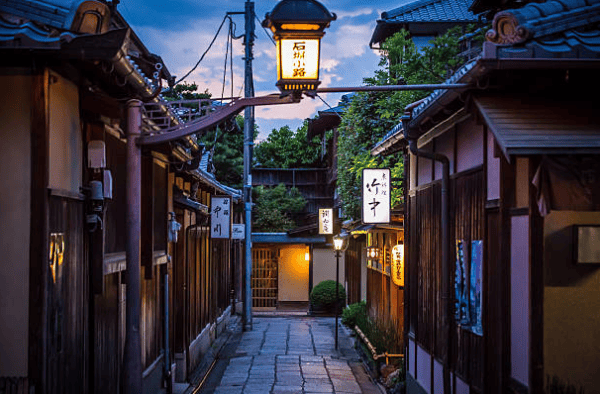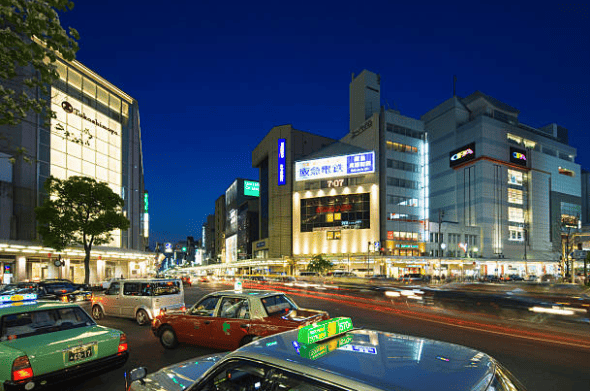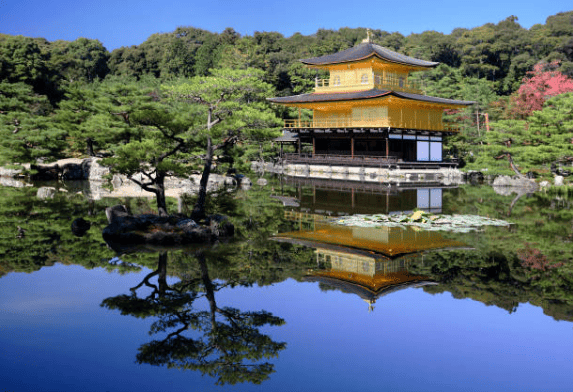After nearly three hours on the Shinkansen from Odawara, following my journey to Mount Fuji and Hakone, I finally arrived in Kyoto—a city that once served as Japan’s capital.
If our impression of Kyoto from photos is that it’s a traditional Japanese city, that impression fades as soon as you arrive at Kyoto Station. This station, like those in Tokyo, is modern and vast, serving as both a subway and Shinkansen terminal and integrated with the city bus terminal. Stepping outside, there’s no sign that this city could be considered traditional. Kyoto is also a modern city with wide streets and, naturally, a bustling atmosphere.
Directly in front of the station, Kyoto Tower stands tall, easily visible among the other buildings in Kyoto.

Since I was staying at the ANA Crowne Plaza Hotel, a free shuttle bus was available from Kyoto Station to the hotel, helping me save on transportation for my two-night stay. The hotel also offers a prime location right across from Nijo Castle, which is a nice bonus.
Kyoto Itinerary
- Gion
- Kinkaku-ji
- Nijo Castle
- Side Trip: Fushimi Inari Shrine
- Side Trip: Nara
Kyoto can serve as a base if you prefer not to stay in Osaka. The two cities are only about 23 minutes apart by Shinkansen (covered by the Japan Rail Pass, if you have one). There are also direct train routes from Kyoto to Osaka Kansai Airport (KIX). Additionally, Kyoto is close to several smaller, tourist-friendly cities like Nara and Inari.
To fully experience Kyoto, a minimum of three days is recommended to cover the main attractions. I’ve summarized everything on one page, but I actually completed this itinerary over three days (including Nara).
Getting Around Kyoto
There are two main modes of transportation for sightseeing in Kyoto: subway and bus.
If you have an IC card (such as Pasmo, Suica, or ICOCA), you can use it on Kyoto’s buses or subways.
Subway
The subway system has only two lines: the Karasuma Line (north-south) and the Tozai Line (east-west). These mostly cover downtown areas and are not particularly useful for tourists.
A one-day subway pass is available for ¥600. If you plan to take more than two trips, it’s worth getting this pass at the station counter.
Bus
City buses are marked with orange-colored route signs. Other colors signify private buses with less frequent schedules. Since there are only two subway lines that don’t cover all areas, we mostly rely on city buses to reach temples or tourist spots. For bus routes, I used Google Maps.
Boarding a bus is similar to Tokyo’s system: enter from the middle door, take a ticket, and pay the driver when you get off. The flat fare is typically ¥230.
A one-day pass for city buses costs ¥500. To purchase this, simply board the city bus (from the middle door) and buy it from the driver. The card will be stamped with the date on the back. For subsequent trips, just show the pass to the bus driver.
Gion

After checking in at the hotel and sorting out my luggage, it was already dark around 6 p.m. My first destination was Gion, where I planned to find some dinner.
Not far from Gion-Shijo Station, I came across a small restaurant called Issen Yoshoku, which serves Kyoto-style okonomiyaki. The food was quite good, but the table decor was a bit creepy—dining with a kimono-clad mannequin and some intriguing wall decorations.
Gion is a district famous for geisha and maiko. This is a respectable and esteemed profession in Kyoto, quite different from the way it’s portrayed in Hollywood films.
Geiko and maiko (Kyoto’s terms for geisha and their apprentices) work in tea houses or restaurants, mainly along Hanami-koji Street. They accompany guests for traditional kaiseki meals, which can easily cost over a million rupiah per person. Restaurants with red lanterns at the entrance often indicate the presence of geisha. It’s said you need a bit of luck to catch sight of a geisha walking here.
Shijo-Dori

One of Kyoto’s main shopping streets is Shijo-Dori, located a few hundred meters east of Gion. You can get here directly by subway (Shijo Karasuma Station or Gion Shijo).
Popular Kyoto souvenirs include traditional fans and matcha (green tea) treats. Almost every snack has a matcha version—KitKats, candies, chocolates, and even ice cream. Several narrow alleys, like Shinkyogoku and Teramachi, feature shops selling these items.
Kinkaku-ji

Kinkaku-ji (Temple of the Golden Pavilion) is definitely a must-visit in Kyoto. It’s stunning and truly breathtaking in photos.
I started from the ANA Crowne Plaza Hotel and took bus number 101 or 12 for about 20 minutes from the stop in front of Nijo Castle.
Though it looks historic, this Zen temple was actually rebuilt in 1955, with the golden coating added in 1987.
Entrance costs ¥400 per person, and you’ll receive a ticket that resembles a charm paper. The area is quite large, so be ready for some exploring.
The paths are one-way, so you just follow the crowd. The first building you’ll see is the iconic golden pavilion. Then, the path leads to a garden with a tea area where you can enjoy matcha and a small snack (for an additional fee) in a simple Japanese tea ceremony.
Nijo Castle

Nijo Castle (二条城, Nijōjō) may resemble a fortress, but it was actually the residence of Shogun Tokugawa during the Edo period.
The main building here is Ninomaru Palace, which served as the Shogun’s home. It’s essentially a series of interconnected houses. Photography isn’t allowed inside, so it’s an experience to enjoy with your own eyes. You also need to remove your shoes to walk through. An interesting feature here is the “nightingale floor,” designed to creak as you walk, alerting the Shogun to any intruders.
The castle grounds are vast, with a double-layered defense wall and a single entrance gate. The gardens are beautiful, so plan to spend 3-4 hours exploring.
Fushimi Inari & Nara
When in Kyoto or Osaka, you can take a day trip to Inari and Nara. I’ve written about my visit to Fushimi Inari Shrine in a separate article:
– Fushimi Inari
– Nara
Both are highly recommended additions to your itinerary.
